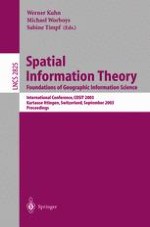2003 | OriginalPaper | Buchkapitel
“Simplest” Paths: Automated Route Selection for Navigation
verfasst von : Matt Duckham, Lars Kulik
Erschienen in: Spatial Information Theory. Foundations of Geographic Information Science
Verlag: Springer Berlin Heidelberg
Enthalten in: Professional Book Archive
Aktivieren Sie unsere intelligente Suche, um passende Fachinhalte oder Patente zu finden.
Wählen Sie Textabschnitte aus um mit Künstlicher Intelligenz passenden Patente zu finden. powered by
Markieren Sie Textabschnitte, um KI-gestützt weitere passende Inhalte zu finden. powered by
Numerous cognitive studies have indicated that the form and complexity of route instructions may be as important to human navigators as the overall length of route. Most automated navigation systems rely on computing the solution to the shortest path problem, and not the problem of finding the “simplest” path. This paper addresses the issue of finding the “simplest” paths through a network, in terms of the instruction complexity. We propose a “simplest” paths algorithm that has quadratic computation time for a planar graph. An empirical study of the algorithm’s performance, based on an established cognitive model of navigation instruction complexity, revealed that the length of a simplest path was on average only 16% longer than the length of the corresponding shortest path. In return for marginally longer routes, the simplest path algorithm seems to offer considerable advantages over shortest paths in terms of their ease of description and execution. The conclusions indicate several areas for future research: in particular cognitive studies are needed to verify these initial computational results. Potentially, the simplest paths algorithm could be used to replace shortest paths algorithms in any automated system for generating human navigation instructions, including in-car navigation systems, Internet driving direction servers, and other location-based services.
